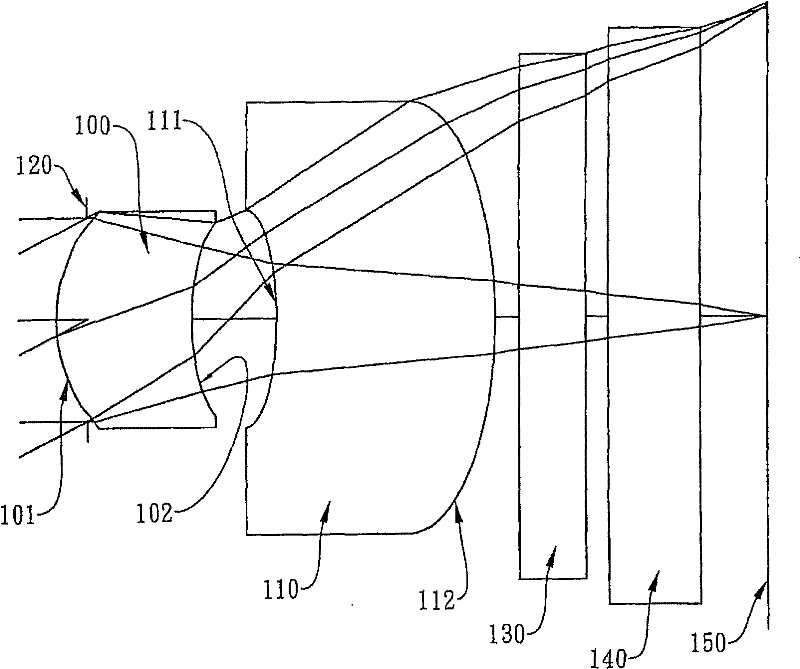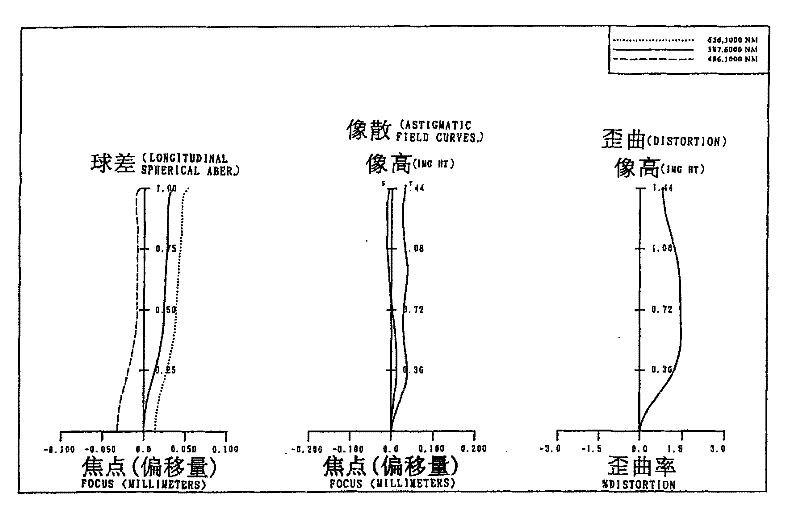Thin photographic optical lens group
An optical mirror and thin technology, applied in optics, optical components, televisions, etc., can solve the problems of increased sensitivity of the optical system, enhanced lens refractive power, and difficult yield control, etc., to reduce the possibility of vignetting, photosensitive Effects of increased sensitivity and shortened total optical length
- Summary
- Abstract
- Description
- Claims
- Application Information
AI Technical Summary
Problems solved by technology
Method used
Image
Examples
no. 1 example
[0091] Please refer to the first embodiment of the present invention figure 1 , for the aberration curve of the first embodiment, please refer to figure 2 . The thin photographic optical lens group of the first embodiment is mainly composed of two lenses with refractive power, and sequentially includes from the object side to the image side:
[0092] A first lens 100 with positive refractive power has a convex front surface 101 and a concave rear surface 102 made of plastic. Both the front surface 101 and the rear surface 102 of the first lens are aspherical;
[0093] A second lens 110 with negative refractive power, the front surface 111 is concave, the rear surface 112 is convex, and its material is plastic, and the front surface 111 and the rear surface 112 of the second lens are both aspherical;
[0094] An aperture 120 is placed in front of the first lens 100;
[0095] In addition, an infrared filter 130 (IR Filter) is placed behind the second lens 110; and a photosen...
no. 2 example
[0124] Please refer to the second embodiment of the present invention image 3 , for the aberration curve of the second embodiment, please refer to Figure 4 . The thin photographic optical lens group of the second embodiment is mainly composed of two lenses with refractive power, and sequentially includes from the object side to the image side:
[0125] A first lens 300 with positive refractive power has a convex front surface 301 and a concave rear surface 302 made of plastic. Both the front surface 301 and the rear surface 302 of the first lens are aspherical;
[0126] A second lens 310 with negative refractive power, the front surface 311 is concave, the rear surface 312 is convex, and its material is plastic, the second lens front surface 311, rear surface 312 are both aspherical;
[0127] An aperture 320 is placed in front of the first lens 300;
[0128] The thin photographic optical lens group also includes an infrared filter 330 (IR Filter) placed behind the second ...
no. 3 example
[0151] Please refer to the third embodiment of the present invention Figure 5 , for the aberration curve of the third embodiment, please refer to Figure 6 . The thin photographic optical lens group of the third embodiment is mainly composed of two lenses with refractive power, and sequentially includes from the object side to the image side:
[0152] A first lens 500 with positive refractive power, its front surface 501 is convex, its rear surface 502 is concave, its material is plastic, the first lens front surface 501, rear surface 502 are both aspherical;
[0153] A second lens 510 with negative refractive power, the front surface 511 is concave, the rear surface 512 is convex, and its material is plastic, and the front surface 511 and the rear surface 512 of the second lens are both aspherical;
[0154] An aperture 520 is placed in front of the first lens 500;
[0155] The thin photographic optical lens group also includes an infrared filter 530 (IR Filter) placed beh...
PUM
 Login to View More
Login to View More Abstract
Description
Claims
Application Information
 Login to View More
Login to View More - R&D
- Intellectual Property
- Life Sciences
- Materials
- Tech Scout
- Unparalleled Data Quality
- Higher Quality Content
- 60% Fewer Hallucinations
Browse by: Latest US Patents, China's latest patents, Technical Efficacy Thesaurus, Application Domain, Technology Topic, Popular Technical Reports.
© 2025 PatSnap. All rights reserved.Legal|Privacy policy|Modern Slavery Act Transparency Statement|Sitemap|About US| Contact US: help@patsnap.com



